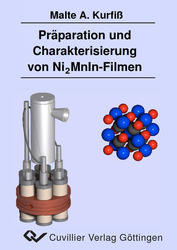| Departments | |
|---|---|
| Book Series (96) |
1378
|
| Nachhaltigkeit |
3
|
| Gesundheitswesen |
1
|
| Humanities |
2363
|
| Natural Sciences |
5406
|
| Mathematics | 229 |
| Informatics | 319 |
| Physics | 980 |
| Chemistry | 1363 |
| Geosciences | 131 |
| Human medicine | 243 |
| Stomatology | 10 |
| Veterinary medicine | 108 |
| Pharmacy | 147 |
| Biology | 835 |
| Biochemistry, molecular biology, gene technology | 121 |
| Biophysics | 25 |
| Domestic and nutritional science | 45 |
| Agricultural science | 1004 |
| Forest science | 201 |
| Horticultural science | 20 |
| Environmental research, ecology and landscape conservation | 148 |
| Engineering |
1791
|
| Common |
97
|
|
Leitlinien Unfallchirurgie
5. Auflage bestellen |
|
Advanced Search
Präparation und Charakterisierung von Ni2MnIn-Filmen (English shop)
Malte A. Kurfiß (Author)Preview
Table of Contents, Datei (33 KB)
Extract, Datei (110 KB)
Seit dem Vorschlag von S. Datta und B. Das, einen Spintransistor zu entwickeln, besteht ein großes Interesse an elektronischen Bauteilen, die als Informationsträger die Spin-Ausrichtung der Elektronen und nicht nur deren Ladung verwenden. Eine Herausforderung bei der Entwicklung solcher Bauteile ist es, einen spinpolarisierten Strom in einen Halbleiter zu injizieren. Ein vielversprechendes Material für eine spinpolarisierte Elektrode ist die Heusler-Legierung Ni2MnIn.
Einige Heusler-Legierungen gehören zu der Materialklasse der sogenannten halbmetallischen Ferromagnete. Bei diesen Materialien ist das Valenzband der „spin-up“-Elektronen teilweise besetzt, so daß diese Elektronen zum Ladungstransport beitragen, während das Valenzband der „spin-down“-Elektronen unterhalb der Fermi-Kante liegt und folglich nicht zum Ladungstransport beitragen kann. Halbmetallisches Verhalten ist für Ni2MnIn an der Grenzfläche zu Indiumarsenid vorhergesagt.
Dünne Ni2MnIn-Schichten wurden durch Verdampfen der Komponenten hergestellt. Dabei sind ein Drei-Quellen- und ein Zwei-Quellen-Verdampfer zum Einsatz gekommen. Die Verwendung von nur zwei Verdampferquellen ist möglich, da die Dampfdrücke von Mangan und Indium dicht beieinander liegen.
Die hergestellten Schichten wurden mit Raster- und Transmissionselektronenmikroskopen auf ihre Morphologie, Kristallstruktur und Stöchiometrie hin untersucht. Der Bereich der Substrattemperatur von 200 °C bis 300 °C, bei der sich die Legierung zur L21-Struktur der Heusler-Legierungen ordnet, wurde ermittelt. Diese Ordnung ist für die magnetischen Eigenschaften und damit für die Spinpolarisation der Leitungselektronen entscheidend.
Mit einem SQUID-Magnetometer wurden an den Proben die Temperaturabhängigkeit der Magnetisierung, die Curie-Temperatur und die Sättigungsmagnetisierung gemessen. Die Ergebnisse zeigen eine gute Übereinstimmung mit Daten aus der Literatur für Volumenmaterial.
Die Spinpolarisation der Ni2MnIn-Schichten wurde mit dem Verfahren der Punktkontakt-Andreev-Reflexion gemessen. Der Polarisationsgrad der Ni2MnIn-Schichten ist deutlich höher als der konventioneller ferromagnetischer Spininjektoren.
Since S. Datta and B. Das proposed to develop the spin transistor, there is great interest in devices which use the orientation of the electron spin instead of the charge to store and manipulate information. The injection of spin polarized electrons into a semiconductor is challenging. A promising material for this task is the Heusler alloy Ni2MnIn.
Some Heusler alloys belong to the class of so called half-magnetic ferromagnets. In these materials the valence band of the spin-up electrons is partially occupied, i.e. these electrons take part in the charge transport. The valence band of the spin-down electrons is well beyond the Fermi-level, i.e. it shows insulating behavior. Half-metallic properties are predicted for the Ni2MnIn – indium arsenide interface.
Thin films of Ni2MnIn were grown by vapor deposition. For the preparation two methods were used, one with three evaporation sources for nickel, manganese and indium and one with two sources. In the latter case manganese and indium were alloyed and evaporated from the same crucible because of their nearly identical vapor pressures.
The Ni2MnIn films were investigated by scanning and transmission-electron-microscopy in order to determine their morphology, structure and stoichiometry. The optimum temperature of 200 °C – 300 °C for growing the ordered L21-structure of Heusler alloys has been determined. The ordered structure is essential for the magnetic properties of the Heusler alloy and therefore important for the spin polarized behavior of the conductance electrons.
The temperature dependence of the magnetization, the Curie-temperature, and the saturation magnetization have been measured by SQUID-magnetometry. Their values correspond well with the data of bulk material obtained from the literature. Deviations of the magnetic properties from bulk values are due to the morphology of the layers.
The spin polarization of the Ni2MnIn -films has been measured by point contact Andreev reflection spectroscopy. The detected degree of polarization is well above the polarization of conventional ferromagnetic electrodes.
| ISBN-13 (Printausgabe) | 3865374239 |
| ISBN-13 (Hard Copy) | 9783865374233 |
| ISBN-13 (eBook) | 9783736914230 |
| Final Book Format | A5 |
| Language | German |
| Page Number | 118 |
| Edition | 1 |
| Volume | 0 |
| Publication Place | Göttingen |
| Place of Dissertation | Göttingen |
| Publication Date | 2005-04-15 |
| General Categorization | Dissertation |
| Departments |
Physics
|








